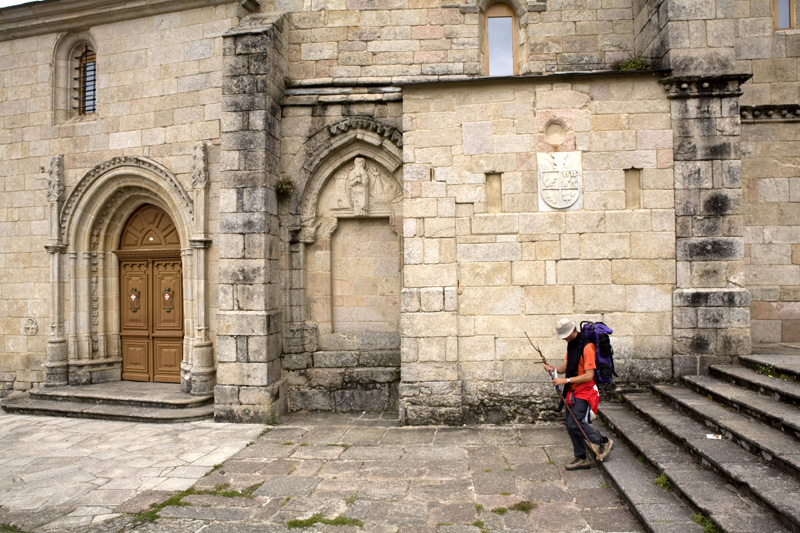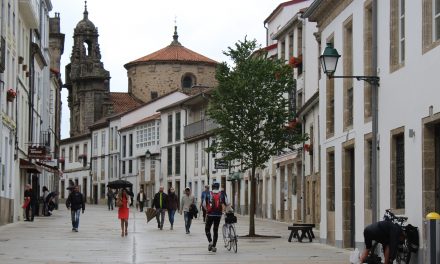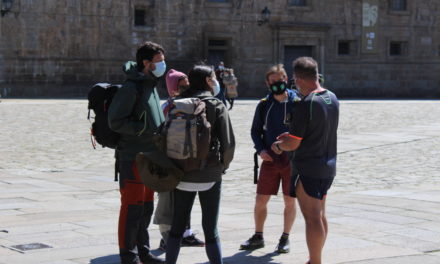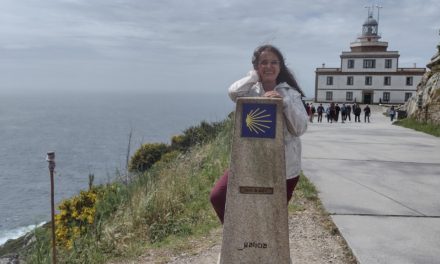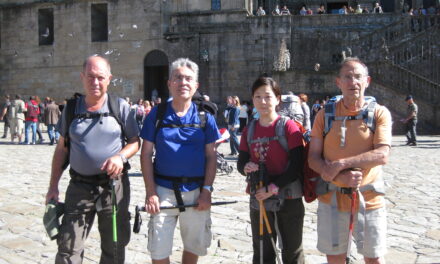Through the testimony of pilgrims from other centuries we can reconstruct the town of Sarria as it was throughout its history. Thanks to their stories we know the central importance of its fortress, its convent and the bridge that allowed pilgrims to pass through to continue their Camino.
The first descriptions of pilgrims that we know of are from the end of the 15th century and the beginning of the 16th century. These are references to a small fortified village, a fortress that at that time must have been seen in all its splendour, since it was not until the 19th century that it lost most of its buildings, with only one of its towers remaining today. The fact that pilgrims always refer to that fortress or castle allows us to imagine how impressive it must have been, thus Arnold von Harff, a pilgrim in 1496-1498, referred to “… Zarea (Sarria), an exemption with a mountain fortress ” and Claude de Bronseval, a pilgrim in 1532-1533, wrote: “… along a pleasant but steep path we descended into a very fertile valley, on one of whose banks, on the other side of a bridge and a river called Sarria, a small fortified town named Sarria is located, where our horses were well treated. We, for our part, are quite well, but we sleep poorly. This fortified town is located at the foot of a mountain and under its summit there is a castle.”
In the 16th century, the Magdalena monastery was in the full ferment of construction. It had been created more than a hundred years earlier under the tutelage of some Italian friars who dedicated themselves to repairing bridges, undoubtedly part of an order similar to that of the Tau, so closely linked to pilgrimage. In the 16th century the old convent was transformed into an important Augustinian monastery, with various buildings, a hospital and a pilgrimage centre
, and was still in charge of ensuring the good condition of the nearby bridge that allowed pilgrims to cross: the Ponte Áspera, which is still standing today.
Much of the information we have about that monastery is due to the stories of pilgrims, pilgrims like Domenico Laffi, an Italian who wrote a long account of his pilgrimages in 1663, 1670 and 1673. Laffi has left us a long description of the Sarria that the pilgrims of that time passed through: “This is a very beautiful and rich land, with beautiful buildings and there is a convent of friars dressed in white, who give way to the pilgrims. Above it there is a beautiful and strong castle, with very high walls around which is the Lord of said land who also gives the transfer of money to the pilgrims who come to San Giacomo di Galitia and here justice is done, being this absolute patron.”
A few decades later, another Italian, Giacomo Antonio Naia, a pilgrim to Santiago in 1717-1718, refers again to the fortress and the monastery. In his story, Naia also specifies the layout of the Augustinian monastery outside the fortress walls, which allows us to know a little more about the importance of the buildings that surrounded the castle: “So at night I stayed with Padres de S. Augustine number 12, outside the walls, near the beautiful Fortress, and they received me with great charity, and I was very happy to eat and drink in the Refectory, and afterwards was given a good bed, and a big fire to dry myself. In the morning I fulfilled my obligations, then in the Refectory I had a generous hearty breakfast and a large jug of good red wine, which was more than enough. Afterwards, from some of those Religious fathers, I received fine tobacco and fine paper for writing, and these similar things and others have happened to me in almost all the Convents. The Lord Priest of this Land gave me a Royal Medium here then there is the reception of the Pilgrims (…) then I thanked that Father Prior, and all the other Fathers, and I continued on the path.”
Naia’s story also contains an important reference about the help that the pilgrims received in the town: “The Lord of this Land gave me the Royal Means. Behold, then, the host of the Pilgrims. There is still the Lord Governor of this fortress who gives the passage of certain dinars to the Pilgrims who return from S. Giacomo di Gallizia, and not to those who go…” These references from Naia make us see many things, on the one hand, it was not only the monastery and the hospitals who helped the pilgrims, but also the civil authorities, among whom the help was distributed to the pilgrims who were going to or returning from Santiago. Specifically, in Naia’s time, it seems that the church was in charge of welcoming and helping those who walked to Santiago – the convent and the parish priest – while the representative of the lord of the town and its fortress – the Count of Lemos -, was responsible for the San Antonio hospital, which was dependent on the civil authority of the town and was located very close to the fortress, which would be in charge of the pilgrims who returned after their pilgrimage on their way home. What Naia tells us, reminds us that the network of hospitality and help of the Camino was intended for pilgrims who travelled the roads in both directions: on the way to Santiago and back to their homes.
All this assistance activity allows us to assume that there was another parallel activity around the hospitality towards pilgrims, such as in Triacastela and Portomarín, about which there are, however, no such clear references. However, we do have a famous reference to economic activity in Sarria, to the importance of livestock, specifically pig farming. This is a very old reference, from Jerónimo Münzer, a pilgrim to Santiago in 1494-1495, whose controversial condition is easy to understand, he wrote: “… we arrived at the small place of Sarrià. This entire route has fertile and mountainous land, but sparsely inhabited. These people feed mainly on pork, and in all their actions they are truly pigs.”
The truth is that the subsequent references that we have mentioned usually give a very positive vision of the town, dedicated, as today, to welcoming pilgrims, with its fortress and monastery, its pilgrim hospitals and emblazoned houses.

